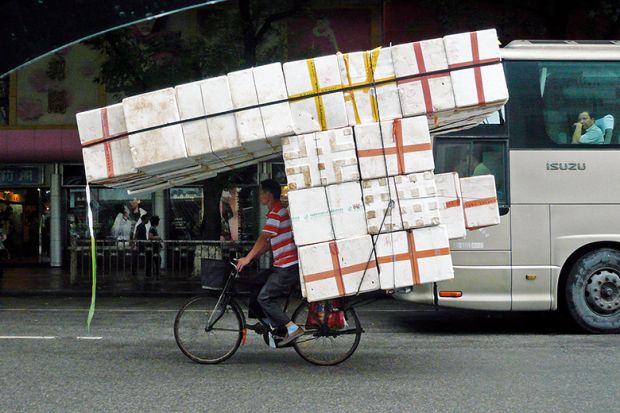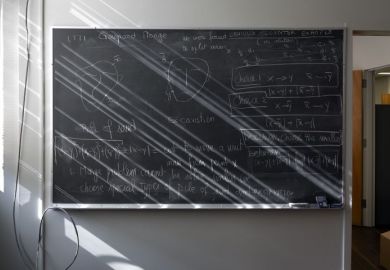If you ever want to see mathematicians get really excited, ask them about Hagoromo Fulltouch Chalk.
“There’s a scene in La La Land,” said Dave Bayer, professor of mathematics at Columbia University’s Barnard College, “where Ryan Gosling is under a spotlight playing a toy electric piano one handed during his stint with a ‘popular’ group, and the film is brutally clear how this is shredding his soul. Most mathematicians that I know feel this way about whiteboards.”
Writing on a blackboard with the deluxe Japanese chalk made of oyster shells, by contrast, was “like skiing on fresh powder, or waterskiing at dawn on a calm Adirondack Lake”.
Wei Ho, associate professor of mathematics at the University of Michigan, was equally enthusiastic, if less poetic. Hagoromo Fulltouch Chalk, she believed, “writes much more smoothly than any other chalk that I have used. I don’t have to think about pressing too softly – some chalk won’t show up without enough pressure – or pressing too hard or squeaking…With other brands, usually after a lecture, my hands – and clothes! – are covered in chalk.” It was “especially useful for giving lectures where there’s more time pressure, so you don’t want to waste time and energy thinking about your chalk as you are writing”.
There is even a legend circulating in the maths community that it is impossible to prove a false theorem while using Hagoromo Fulltouch Chalk.
Not all mathematicians, Professor Bayer admitted, cared about chalk (though those who didn’t were often equally obsessed with “a typesetting package called microtype that optically aligns margins”). Yet it was undoubtedly a bleak day when in October 2014, after 82 years of production, Takayasu Watanabe, the last president of Hagoromo Stationery, decided to close down the company. He cited both his own poor health and “an operating loss” resulting from a decline in sales from a peak of 90 million sticks a year to half that level. Yet he was confident that production would continue, since he had sold on the machines for making and moulding the chalk to a local stationery manufacturer and a Korean importer called Sejongmall, and he had plans “to visit South Korea and teach my know-how”.
Yet many mathematicians were not convinced by his reassurances and responded instantly to what one described as a “chalk apocalypse”.
“When I heard that the factory had gone out of business,” said Ezra Getzler, professor of mathematics at Northwestern University, “I bought a lifetime’s supply of the stuff on Amazon.” This amounted to 10 boxes of white chalk, each with 72 sticks, and two boxes of coloured chalk, costing a total of $280 (£200).
Even more dramatic was Professor Bayer’s response. “I read in the middle of the night on social media that the Japanese company had closed. I still had a reasonable stockpile, but I went on Amazon and bought every remaining box for sale in the United States,” he said.
Having acquired his treasures, he “built a padded attaché case for carrying the chalk. This reduced breakage; I now clearly have more than enough chalk to last my career. My students have spoken for my supply when I retire.”
Dr Ho also recalled how, a few years ago, “certain professors would be known to have stockpiles of Hagoromo, and they would bring two sticks to seminars to give the speaker – usually a visitor – who would be very appreciative!”
Two further developments have cast new light on this hoarding behaviour. Despite teething problems with machinery, Sejongmall is indeed manufacturing the chalk again, which means that it is easily available on Amazon. Professor Bayer suspected “one can probably tell the two versions of Hagoromo chalk apart – like new owners buying a pizza joint – but they are close, and either is vastly better than most alternatives”.
The Covid pandemic has seen several episodes of people rushing out to stockpile oil, tinned vegetables and toilet paper. But the shift to online teaching has called into question the wisdom of those who thought they were showing great foresight in stockpiling mathematical chalk.
“To be honest,” reported Dr Ho, “I haven’t been at a chalkboard since March 2020.” Professor Getzler now “did all of [his] teaching with a good-quality digital camera, pen and paper. Over Zoom, obviously.” And even Professor Bayer had felt forced to “learn to write mathematics on an iPad using an Apple Pencil”.
“I’m perplexed by the question of how I will teach in the fall,” he reflected. “I will probably distribute digitally drawn notes” but might still “review the same content by hand on a blackboard”.
POSTSCRIPT:
Print headline: Has mathematicians’ favourite Japanese chalk lost its silk touch?
Register to continue
Why register?
- Registration is free and only takes a moment
- Once registered, you can read 3 articles a month
- Sign up for our newsletter
Subscribe
Or subscribe for unlimited access to:
- Unlimited access to news, views, insights & reviews
- Digital editions
- Digital access to THE’s university and college rankings analysis
Already registered or a current subscriber? Login








